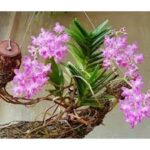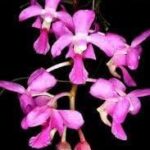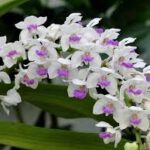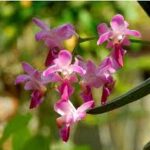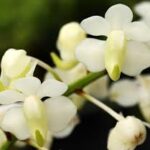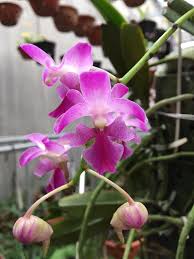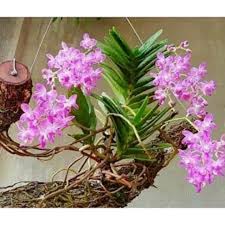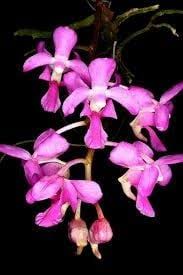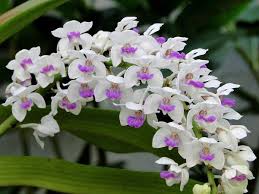
Sato Cymbidium orchids are known for their elegance, vibrant colors, and long-lasting blooms, making them a favorite among orchid enthusiasts worldwide. However, not all Sato Cymbidium varieties are suited for every climate. Choosing the right variety based on your local weather conditions is crucial for successful cultivation and growth. This article will explore the factors that influence the selection of Sato Cymbidium orchids, helping you identify the best variety for your climate.
## 1. Understanding the Climate Needs of Sato Cymbidium Orchids
Before selecting a Sato Cymbidium variety, it’s essential to understand the general climate requirements of these orchids. Typically, Sato Cymbidium orchids thrive in environments that mimic their natural habitat, which can vary depending on the specific variety. Generally, they prefer cool to intermediate temperatures, with moderate humidity and good air circulation.
### 1.1 Temperature Requirements
Sato Cymbidium orchids are primarily cool-growing plants that flourish in cooler climates. During the day, they prefer temperatures between **18°C and 24°C (65°F to 75°F)**. Night temperatures should drop to around **10°C to 15°C (50°F to 60°F)**. This day-night temperature fluctuation is crucial for their growth and flower production. When choosing a variety, consider the temperature variations in your area to ensure a suitable match.
### 1.2 Humidity Preferences
Humidity is another key factor to consider. Sato Cymbidium orchids generally require **moderate humidity levels, ranging from 40% to 60%**. In regions with low humidity, you may need to use a humidifier or place the orchids on a humidity tray to maintain optimal moisture levels. Conversely, in areas with high humidity, ensure proper ventilation to prevent fungal growth and other issues.
### 1.3 Light Conditions
While not directly related to climate, light conditions play a vital role in the health and blooming of Sato Cymbidium orchids. These orchids require **bright, indirect sunlight**. In areas with intense sunlight, providing shade is necessary to prevent leaf scorching. If you live in a region with lower natural light, you may need to supplement with grow lights to provide the necessary light exposure.
## 2. Choosing Sato Cymbidium Varieties for Cool Climates
In cool climates, where temperatures are consistently lower throughout the year, selecting Sato Cymbidium varieties that are well-adapted to cooler conditions is essential. Some varieties are naturally more tolerant of cooler temperatures, and they will thrive without requiring additional heating or special care.
### 2.1 Recommended Cool Climate Varieties
– **Sato Cymbidium ‘Cool Breeze’**: This variety is known for its tolerance to lower temperatures and is often recommended for growers in cooler regions. It produces beautiful white and pink blooms and can withstand night temperatures close to 5°C (41°F) without damage.
– **Sato Cymbidium ‘Winter Frost’**: As the name suggests, this variety is perfect for areas with cold winters. It has robust flowers that bloom even in cooler weather, making it an ideal choice for cooler climates.
– **Sato Cymbidium ‘Alpine Glow’**: Known for its resilience in cooler temperatures, this variety is prized for its large, glowing blooms. It is a hardy plant that can thrive in conditions where other orchids might struggle.
### 2.2 Care Tips for Cool Climate Growing
When growing Sato Cymbidium orchids in cool climates, it’s important to monitor temperature drops, especially during the winter. While many varieties can handle cooler nights, prolonged exposure to freezing temperatures can damage the plants. Ensure that your orchids are sheltered from frost and cold winds by keeping them in a greenhouse or indoor environment during extreme cold spells.
## 3. Selecting Sato Cymbidium Varieties for Warm Climates
For those living in warmer climates, selecting heat-tolerant Sato Cymbidium varieties is crucial. While these orchids are typically cool-growing, some varieties have been developed or adapted to withstand higher temperatures, especially during the summer months.
### 3.1 Recommended Warm Climate Varieties
– **Sato Cymbidium ‘Sunshine Delight’**: This variety is specifically bred for warmer regions. It can tolerate higher daytime temperatures and is less susceptible to heat stress. Its bright yellow blooms are a delightful sight, even in warmer climates.
– **Sato Cymbidium ‘Tropic Flame’**: Adapted to warmer environments, this variety can thrive in temperatures up to 30°C (86°F) during the day. It is an excellent choice for growers in tropical or subtropical regions.
– **Sato Cymbidium ‘Golden Sands’**: With its ability to withstand heat and humidity, this variety is perfect for areas with hot, humid summers. It produces striking yellow and orange flowers that add a touch of tropical beauty to any collection.
### 3.2 Care Tips for Warm Climate Growing
For growers in warm climates, it’s essential to provide adequate shade to protect Sato Cymbidium orchids from direct sunlight, especially during peak hours. Consider using shade cloths or growing the plants under trees where they receive dappled sunlight. Ensure proper air circulation to prevent heat buildup around the plants, which can lead to stress and inhibit blooming.
## 4. Adapting Sato Cymbidium Orchids for Temperate Climates
In temperate regions, where there are distinct seasonal variations, selecting Sato Cymbidium varieties that can adapt to fluctuating temperatures is key. Many growers in these areas prefer varieties that can tolerate a range of conditions, from warm summers to cooler winters.
### 4.1 Recommended Temperate Climate Varieties
– **Sato Cymbidium ‘Spring Melody’**: This variety is highly adaptable and can handle moderate temperature shifts. It blooms beautifully in spring, making it a popular choice for temperate climates.
– **Sato Cymbidium ‘Autumn Glow’**: Ideal for regions with mild autumns, this variety produces vibrant, warm-colored blooms that echo the hues of autumn leaves. It is resilient to moderate temperature fluctuations.
– **Sato Cymbidium ‘Seasonal Charm’**: This versatile variety can adjust to both cooler and warmer temperatures, making it suitable for regions with significant seasonal changes. It blooms profusely in spring and early summer.
### 4.2 Seasonal Care Tips
In temperate climates, it’s crucial to adjust care routines based on the season. During warmer months, provide shade and increase watering frequency to prevent dehydration. As temperatures drop in autumn and winter, reduce watering and ensure that the orchids are protected from frost. These seasonal adjustments will help maintain healthy growth and encourage blooming.
## 5. The Role of Microclimates in Orchid Selection
While regional climate is a major factor in choosing the right Sato Cymbidium variety, local microclimates can also influence orchid growth. A microclimate refers to the climate in a specific, localized area that may differ from the surrounding region.
### 5.1 Creating a Microclimate for Sato Cymbidium
If your local climate is not ideal for Sato Cymbidium orchids, you can create a microclimate to meet their needs. For instance, planting your orchids near a pond can increase humidity, while placing them under a canopy of trees can provide shade and reduce temperature fluctuations.
### 5.2 Indoor Growing for Controlled Conditions
For growers in areas with extreme climates, indoor cultivation may be the best option. Growing Sato Cymbidium orchids indoors allows you to control temperature, humidity, and light exposure. Invest in grow lights, humidifiers, and fans to replicate the ideal conditions for your orchids, ensuring they receive the care they need regardless of the external climate.
## Conclusion
Choosing the right Sato Cymbidium orchid variety involves understanding your local climate and selecting plants that are well-adapted to those conditions. By considering factors such as temperature, humidity, and seasonal variations, you can find varieties that will thrive in your environment, leading to healthy growth and abundant blooms. In the next part of this article, we will delve deeper into more specific tips and strategies to optimize the growing environment for Sato Cymbidium orchids across various climates, ensuring your plants reach their full potential.
# How to Choose the Right Sato Cymbidium Orchid Variety for Your Climate (Part 2)
In the first part of this guide, we explored the basic climate needs of Sato Cymbidium orchids and provided recommendations for varieties that thrive in cool, warm, and temperate climates. We also discussed the importance of microclimates and indoor growing to ensure optimal conditions for these elegant orchids. Now, let’s delve into more detailed strategies, including the impact of regional climate variations, choosing disease-resistant varieties, and practical advice for maintaining healthy growth.
## 6. Understanding Regional Climate Variations
The climate in different regions can vary widely, even within the same country or area. These variations can have a significant impact on the selection of Sato Cymbidium varieties. It is essential to assess the specific characteristics of your local climate before deciding which varieties to grow.
### 6.1 Coastal vs. Inland Climates
In coastal regions, the climate tends to be milder with higher humidity levels, making it easier to grow a variety of Sato Cymbidium orchids. However, salt spray and strong winds can sometimes pose a challenge. Selecting salt-tolerant varieties and positioning plants away from direct coastal winds can be beneficial. Coastal growers may consider varieties like **Sato Cymbidium ‘Ocean Mist’**, which has been developed to withstand saltier conditions.
In contrast, inland regions may have more extreme temperature variations. In these areas, choosing varieties that can handle greater fluctuations between day and night temperatures is essential. Orchids like **Sato Cymbidium ‘Mountain Shadow’** are known for their adaptability to inland climates, where nights can be significantly cooler than days.
### 6.2 Tropical vs. Arid Climates
For those living in tropical climates, where temperatures are consistently high and humidity levels remain elevated, it’s vital to choose heat-tolerant varieties. Orchids such as **Sato Cymbidium ‘Tropic Splash’** and **‘Heatwave’** can thrive in these environments. To support their growth, ensure ample air circulation and indirect sunlight.
In arid or desert-like regions, where conditions are dry and temperatures can be scorching, selecting drought-resistant varieties becomes critical. While most Sato Cymbidium orchids do not naturally grow in arid climates, hybrid varieties like **‘Desert Bloom’** have been bred to tolerate dry conditions. Adding humidity trays and misting the plants can help mimic a more suitable environment.
## 7. Choosing Disease-Resistant Varieties
One often overlooked aspect of selecting the right Sato Cymbidium variety is the plant’s resistance to common pests and diseases. In climates where fungal infections or pests are more prevalent, choosing disease-resistant varieties can save you significant time and effort.
### 7.1 Fungal and Bacterial Resistance
Warm, humid climates often see a higher incidence of fungal and bacterial diseases in orchids. If you are growing Sato Cymbidium orchids in such regions, look for varieties that are more resistant to these issues. **Sato Cymbidium ‘Resista’** and **‘Shield’** are examples of varieties known for their resilience against common fungal infections. Regular pruning, maintaining good air circulation, and avoiding overwatering can further reduce the risk of disease.
### 7.2 Pest-Resistant Varieties
In warmer climates, pests such as aphids, spider mites, and mealybugs can be a significant problem for orchid growers. Some Sato Cymbidium varieties have thicker, tougher leaves that make it harder for pests to infest them. Varieties like **‘Stronghold’** are specifically bred to resist pest damage. Additionally, implementing integrated pest management (IPM) strategies can help keep your plants healthy without relying heavily on chemical pesticides.
## 8. Practical Tips for Ensuring Optimal Growth Across Climates
Regardless of the variety chosen, there are universal care practices that can enhance the growth of Sato Cymbidium orchids, ensuring they flourish in different climates. Here are some expert tips:
### 8.1 Soil and Potting Medium
Sato Cymbidium orchids require a well-draining potting medium that allows air to circulate around the roots. The choice of potting material can also depend on the local climate:
– **Cool Climates**: Use a mix of pine bark, perlite, and sphagnum moss to retain moisture but prevent waterlogging.
– **Warm Climates**: Opt for a lighter mix, such as coarse bark and charcoal, to improve drainage and prevent root rot.
– **Arid Climates**: Consider adding a layer of organic mulch on top of the potting mix to help retain moisture in dry conditions.
### 8.2 Watering Techniques
Watering needs will vary based on the local climate and the specific variety. Here are general guidelines:
– **Cool Climates**: Reduce watering during the winter months, allowing the potting mix to dry slightly between waterings.
– **Warm Climates**: Increase the frequency of watering, especially during hot, dry spells. Water early in the day to prevent the growth of mold and mildew.
– **Humid Climates**: Be cautious not to overwater. Ensure pots have excellent drainage, and monitor for any signs of root rot or fungal infections.
### 8.3 Light Management
Proper light management is crucial to the health and blooming of Sato Cymbidium orchids. While most varieties prefer bright, indirect light, the intensity can vary based on climate:
– **Cool and Temperate Climates**: Ensure the plants receive maximum light exposure during shorter days, especially in winter. Placing them near south-facing windows can be beneficial.
– **Warm Climates**: Protect the orchids from harsh, direct sunlight, which can scorch the leaves. Consider using shade cloths during peak sunlight hours.
## 9. Sato Cymbidium Varieties for Beginner Growers
If you’re new to growing Sato Cymbidium orchids, choosing beginner-friendly varieties that are more forgiving to varying conditions can help ensure a positive experience. Here are some varieties that are easier to grow across different climates:
### 9.1 **Sato Cymbidium ‘Easy Bloom’**
This variety is known for its resilience and ease of care, making it perfect for beginners. It can adapt to a range of temperatures and has a high resistance to common pests and diseases.
### 9.2 **Sato Cymbidium ‘Novice’s Joy’**
‘Novice’s Joy’ is designed for growers who may not have the ideal climate for orchids. It can handle moderate temperature fluctuations and requires less precise care than more sensitive varieties.
### 9.3 **Sato Cymbidium ‘Carefree’**
This variety is tolerant of both cool and warm climates, with flowers that bloom reliably every season. It’s an excellent choice for those just starting their orchid-growing journey.
## 10. Creating an Ideal Micro-Environment
Creating a micro-environment that suits the specific needs of your Sato Cymbidium orchids can be the key to successful growth, especially in climates that are less than ideal.
### 10.1 Building a Greenhouse or Shade House
For serious growers, building a small greenhouse or shade house allows greater control over the growing conditions. This environment lets you adjust temperature, humidity, and light, making it easier to grow a wider range of Sato Cymbidium varieties.
### 10.2 Using Grow Lights for Low Light Regions
If your climate lacks sufficient natural sunlight, using grow lights can help supplement the light needs of your orchids. LED grow lights that mimic natural sunlight are ideal for encouraging healthy growth and flowering.
### 10.3 Seasonal Adjustments for Year-Round Health
Adapting your care routine to the changing seasons is essential for the health of Sato Cymbidium orchids. This might include:
– **Increasing humidity levels during dry winters or summers.**
– **Reducing watering and feeding during colder months.**
– **Adjusting light exposure based on seasonal daylight availability.**
## Conclusion
Selecting the right Sato Cymbidium orchid variety for your climate is a combination of understanding local environmental factors and choosing varieties that can adapt to those conditions. By taking into account temperature, humidity, light, and even microclimates, you can grow these stunning orchids successfully, whether you are a novice or an experienced grower. Through careful variety selection and adapting care routines, Sato Cymbidium orchids can bring beauty and elegance to your garden or home all year round.
With the knowledge gained from this guide, you’re now better equipped to make informed decisions about the best Sato Cymbidium orchid varieties for your unique climate. Remember, growing orchids is a journey of patience and observation. As you gain experience, you’ll discover the nuances that will help your orchids flourish, leading to vibrant blooms that add a touch of natural artistry to any setting.

